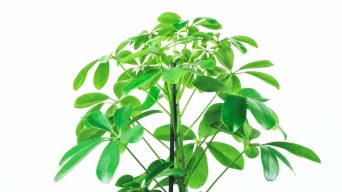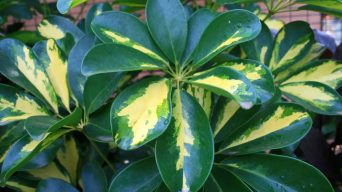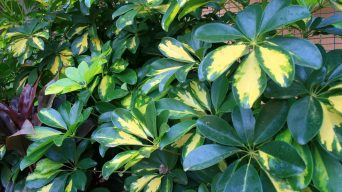A Schefflera plant, or umbrella plant, is a popular indoor houseplant because it is relatively easy to care for.
However, one common problem that umbrella plants face is that their leaves may start to fall off.
Several factors can cause this, but fortunately, some simple solutions can help fix the problem.
In this article, we will discuss why umbrella plant leaves may fall off, as well as tips on keeping your plant healthy and preventing future leaf drop.
What Causes Umbrella Plant Leaves to Fall Off?
The first step in solving any problem is to identify the cause.
There are a few different reasons why umbrella plant leaves may fall off:
1. Overwatering
One of the most common reasons for umbrella plants to lose their leaves is due to overwatering.
Schefflera plants are native to tropical regions and prefer humid conditions.
However, they are not tolerant of soggy soil, which can cause the leaves to turn yellow and eventually drop off.
Check the soil before watering it again if you think your umbrella tree is overwatered.
The top inch or so of soil should be dry to the touch before you water the plant again.
2. Underwatering
While overwatering is a common problem, underwatering can also cause umbrella plant leaves to fall off.
Schefflera plants need to be kept moist but not soggy.
If the soil is allowed to dry out completely, the leaves will start to turn yellow and drop off.
Umbrella plants should be watered when the top inch or so of soil is dry to the touch, and they may need to be watered more frequently in warmer months.
3. Temperature Stress
Another reason umbrella plant leaves may fall off is due to temperature stress.
Schefflera plants prefer warm, humid conditions and can be sensitive to drafts or sudden temperature changes.
Leaves may turn yellow and drop if the plant is exposed to too cold or too hot temperatures.
Keep your umbrella plant in a room between 65 and 80 degrees Fahrenheit with high humidity to prevent temperature stress.
4. Nutrient Deficiency
Nutrient deficiencies can also cause Schefflera leaves to fall off.
Schefflera plants need to be fertilized every month or two during the growing season to ensure they get all the necessary nutrients.
The lack of certain nutrients, such as nitrogen, can cause the leaves to turn yellow and drop off.
If you think your umbrella plant is not getting enough nutrients, fertilize it with a balanced fertilizer made for houseplants, or add some compost to the soil.
5. Too Much Sunlight
While umbrella plants prefer bright indirect light, too much sunlight can cause the leaves to turn yellow and fall off.
If your plant is in a spot with direct sunlight, move it to a location with more shade.
You can also try shading the plant with a sheer curtain or blind to filter out some of the light.
Place your umbrella plant in a bright spot out of direct sunlight, and check the leaves regularly for signs of sunburn.
6. Not Enough Light
While too much sunlight can cause umbrella plant leaves to fall off, not enough light can also be a problem.
Schefflera plants need bright indirect light to thrive, and they will start to lose their leaves if they are not getting enough light.
If your umbrella plant is in a low-light location, try moving it to a brighter spot.
They need at least 4 hours of indirect sunlight each day, so an east- or west-facing window would be a good spot for them.
7. Soil Problems
The quality of the soil can also affect umbrella plants, and poor-quality soil can cause the leaves to fall off.
Schefflera plants prefer a well-draining, slightly acidic soil.
If the soil is too dense or too alkaline, it can cause the leaves to turn yellow and drop off.
To fix this problem, repot your umbrella plant in a potting mix made for tropical plants or add some compost or peat moss to the existing soil.
8. Root Rot
Root rot is a severe problem that can cause umbrella plant leaves to fall off, and if left untreated, your plant may begin to die.
It is caused by overwatering and can kill the plant if it is not treated quickly.
Root rot is a disease that affects the plant’s roots and can be caused by overwatering or poor drainage.
If you think your umbrella plant has root rot, check the roots for signs of decay.
It is a sign of root rot if they are soft or mushy.
Remove the plant from the pot and trim any dead or decaying roots.
Repot the plant in fresh, well-draining soil, and water it properly.
9. Fungal Disease
Fungal diseases can also cause umbrella plant leaves to fall off.
These diseases are caused by fungi that live in the soil, and they can attack the plants’ roots or leaves.
Common fungal diseases include powdery mildew, leaf spot, and root rot.
To prevent fungal diseases, water your umbrella plant at the base of the plant, and don’t let the leaves stay wet for too long.
If you think your plant has a fungal disease, remove the affected leaves and roots.
You can also treat the plant with a fungicide, but it is best to take it to a professional if the problem is severe.
10. Pests
Pests can also cause umbrella plant leaves to fall off.
Common pests that attack umbrella plants include aphids, mealybugs, and whiteflies.
These pests suck the sap out of the leaves, which can cause them to lose their green color and fall off.
You can try treating the plant with an insecticide to eliminate pests.
You can also try making a homemade insecticide by mixing 1 part soap with 10 parts water.
Spray the mixture on the plant leaves and reach all the nooks and crannies where pests like to hide.
You can also remove the pests by hand with a cotton swab dipped in rubbing alcohol.
11. Chemical Burns
If you have recently treated your umbrella plant with a chemical, the leaves are falling off, which could be the reason.
Chemicals like pesticides and herbicides can cause burns on the plant’s leaves, leading to leaf drop.
If you think your umbrella plant has been chemically burned, stop using any chemicals on it and try to flush the soil with water.
To do this, water the plant at the base of the plant and let the water run through the soil for a few minutes. This will help to remove any residual chemicals from the soil.
12. Transplant Shock
Transplant shock is another common reason umbrella plant leaves fall off.
This usually happens when the plant is moved to a new location because the roots are damaged during the transplant process.
To prevent transplant shock, be sure to handle the plant carefully when you are repotting it.
If the roots are damaged, they will not be able to absorb water and nutrients properly, which can cause the leaves to turn yellow and fall off.
If you think your plant is experiencing transplant shock, give it time to adjust to its new location.
It may take a few weeks for the plant to start growing again.
13. Natural Leaf Drop
In some cases, umbrella plant leaves falling off is a natural process.
Some plants, like umbrella plants, shed their leaves during the fall and winter.
This is done to conserve energy and is nothing to worry about.
If your umbrella plant is shedding its leaves, you can let it do its thing.
It’s a natural process, and the plant will grow new leaves in the spring.
What To Do If Your Umbrella Plant Leaves Are Falling Off
If your umbrella plant leaves are falling off, it could be due to several reasons. Maybe the plant is getting too much sun or not enough water. It could also be that the plant is not getting enough nutrients.
Whatever the reason, you can do a few things to try and fix the problem.
If your umbrella plant leaves are falling off, try these tips:
1. Keep Umbrella Plants Out of Direct Sunlight
If your umbrella plant is getting too much sun, the leaves will start to turn yellow and then brown before eventually falling off.
Umbrella plants need bright, indirect light to thrive. So, if your umbrella plant is getting too much sun, try moving it to a spot with less sunlight.
The ideal spot for an umbrella plant gets bright, indirect light, such as near a window that gets morning sun but is shielded from the hot afternoon sun.
2. Make Sure Umbrella Plants Are Getting Enough Water
The leaves will wilt and fall off if umbrella plants don’t get enough water.
Umbrella plants must be watered about once a week or when the soil is dry.
To water an umbrella plant, use lukewarm water and water the plant until the soil is moist but not soggy.
Be careful not to overwater umbrella plants, which can cause the leaves to fall off.
3. Provide Umbrella Plants with the Proper Nutrients
Umbrella plants need to be fertilized about once a month during the growing season.
Use a liquid fertilizer that is high in nitrogen and diluted to half-strength.
Water the plant before applying the fertilizer, and then use the fertilizer on the soil around the base of the plant.
Be sure to follow the instructions on the fertilizer package.
Applying too much fertilizer can also cause umbrella plant leaves to fall off, so use the fertilizer as directed.
4. Prune Off Dead or Damaged Leaves
If umbrella plant leaves fall off because they’re dead or damaged, you can prune them.
Use sharp, clean shears to cut the leaves off at the base.
After you’ve removed the dead or damaged leaves, new growth will emerge from the plant.
5. Repot Umbrella Plants Every Few Years
Umbrella plants need to be repotted every two or three years.
When repotting umbrella plants, use a pot that is only one size larger than the current pot.
Be sure to use well-draining potting soil, and ensure the pot has drainage holes.
If you think your umbrella plant is root-bound, you can gently loosen the roots before repotting.
Doing this will help the plant to absorb water and nutrients more efficiently.
6. Check for Pests
If umbrella plant leaves fall off, they could be due to pests.
Check the plant for signs of pests, such as small holes in the leaves or white fuzzy spots.
If you find any pests on your umbrella plant, you can remove them by hand or treat the plant with insecticide soap or neem oil. This will help to get rid of the pests and prevent further damage to the plant.
7. Check for Disease
If umbrella plant leaves fall off, they could also be due to disease.
Check the plant for signs of disease, such as black spots on the leaves or stems.
If you think your umbrella plant has a disease, you can try treating it with a fungicide. This will help eliminate the disease and prevent further damage to the plant.
You can use a natural fungicide, such as baking soda.
To use baking soda as a fungicide, mix one teaspoon with one quart of water.
Spray the mixture on the affected areas of the plant, and be sure to coat the undersides of the leaves.
Do this every few days until the disease is gone.
8. Inspect the Roots
If umbrella plant leaves are dropping, it could be due to problems with the roots.
Check the roots for signs of damage, such as root rot or rootbound.
If you find any damaged roots, you can try trimming them off. This will help to prevent further damage to the plant.
9. Move Umbrella Plants to a More Humid Location
If umbrella plants are not getting enough humidity, the leaves will start to dry out and fall off.
To increase the humidity around umbrella plants, use a humidifier or place the plants on a pebble tray.
A pebble tray is a tray filled with rocks or pebbles with water.
The water will evaporate and help to increase the humidity around the plants.
You can also mist umbrella plants with water every day to help increase the humidity.
10. Provide Umbrella Plants with More Light
If umbrella plants are not getting enough light, the leaves will start to yellow and fall off.
You can move umbrella plants to a brighter location to give them more light.
You can also use grow lights to give umbrella plants the needed light.
Grow lights are artificial lights that mimic sunlight.
They are available in different intensities and colors, so you can choose the best grow light for umbrella plants.
11. Provide Umbrella Plants with the Right Temperature
If umbrella plants are not getting the right temperature, the leaves will start to fall off.
Umbrella plants prefer temperatures between 60 and 75 degrees Fahrenheit.
To provide umbrella plants with the right temperature, you can move them to a warmer or cooler location.
You can also use a space heater or air conditioner to help maintain the right temperature.
12. Keep Umbrella Plants Away from drafts
If umbrella plants are exposed to drafts, the leaves will turn yellow and fall off.
To keep umbrella plants away from drafts, move them away from doors and windows.
You can also use a screen to help block drafts.
What Are The Benefits Of Umbrella Plant Leaves Falling Off?
Although it may seem like a bad thing, umbrella plant leaves falling off can be beneficial to the plant.
When umbrella plant leaves fall off, it allows the plant to redirect its energy to new growth.
This can help the plant to stay healthy and thrive. Additionally, falling off umbrella plant leaves can help the plant get rid of pests or diseases.
If the leaves are infested with pests or diseased, falling off is a way for the plant to get rid of the problem and start fresh.
Older umbrella plant leaves can also become a burden for the plant.
When umbrella plant leaves fall off, the plant can focus its energy on new growth instead of old, dying leaves.
This can help the plant to stay healthy and thrive.
While falling off umbrella plant leaves can benefit the plant, it is essential to ensure that the plant is not losing leaves due to a problem.
If umbrella plant leaves are falling off due to a problem, it is essential to address the issue so the plant can heal and start growing new leaves.
What Can You Do With Fallen Umbrella Plant Leaves?
If umbrella plants are losing their leaves, you may be wondering what to do with the fallen leaves.
One option is to compost them.
Composting umbrella plant leaves can add nutrients to the soil and help other plants to grow.
To compost umbrella plant leaves, chop them up into small pieces and add them to your compost bin.
Another option is to use the umbrella plant leaves as mulch.
Mulching umbrella plant leaves can help to retain moisture in the soil and prevent weed growth.
To use the plant leaves as mulch, spread a layer of chopped-up leaves around your plants.
As the leaves break down, they will add nutrients to the soil.
While umbrella plant leaves falling off can be beneficial to the plant, it is essential to ensure that the plant is not losing leaves due to a problem.
If umbrella plant leaves are falling off due to a problem, it is essential to address the issue so the plant can heal and start growing new leaves.
Final Thoughts
If umbrella plant leaves are falling off, it could be due to various reasons.
Some common reasons umbrella plant leaves fall off include pests, diseases, overwatering, underwatering, lack of light, and too much sunlight.
In some cases, falling off umbrella plant leaves can benefit the plant.
For example, umbrella plant leaves falling off can help the plant to focus its energy on new growth.
If your umbrella plant leaves are falling off and you’re not sure why, try troubleshooting by ensuring the plant is getting the right amount of water, sunlight, and nutrients.
In general, with the proper care, umbrella plant leaves will stop falling off, and the plant will thrive.







